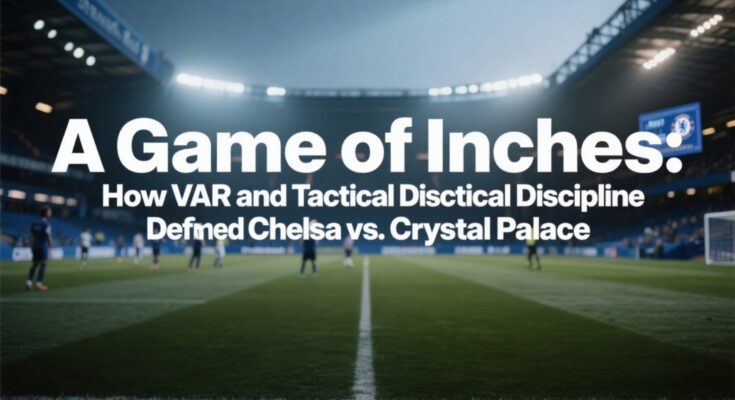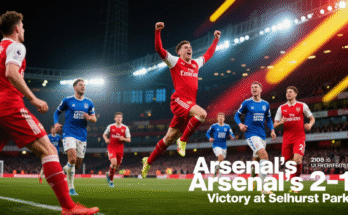This game was the best illustration of how complicated contemporary football can be. It witnessed tremendous defensive spirit of Crystal Palace. Nevertheless, all the buzz was about a controversial VAR call. There was a piece of brilliance by Eberechi Eze wiped out by a technicality. This seemed like it cheated fans of a magnificent moment. This decision went in favor of Chelsea who arguably were lucky. Nevertheless, they did not make use of their good fortune at all. Their costly offensive appeared to be split and not coordinated. It demonstrated that money does not give an immediate teamwork. At the end Crystal got their point using tactical discipline and shear will in abundance. It is sad that the largest debate has been a rule book, and not a wonder goal.
At A Glance
- There was only one controversial VAR decision which ruled out a fantastic free-kick by Eberechi Eze as the critical moment of a nervous draw.
- Chelsea, with its expensive team of assembled attackers amounting to more than 250 million pounds, did not manage to crack down a well-organised and strong defence by Crystal Palace.
- Crystal Palace displayed massive tactical organization, as former chelsea defender Marc Guehi had a masterclass defensively.
- The irritating scoreless outcome instantly raises early-season doubts regarding the tactical continuity and the title prospects of Chelsea.
- The strong show put together by Palace is a confirmation that they stand a chance of fighting tooth and nail with the first team sides in the league, which is anchored by defensive strength.
The Disallowed Goal: A Detailed Breakdown
The moment of the match when Eze stamped out a free-kick was certainly one of its most dramatic ones. To comprehend the decision, it is necessary to refer to a certain technical rule. It occurred with detail and controversy and long after the whistle, the players and fans alike are still playing the moment over. It was precisely the time when the state of affairs between football and technology needed to be depicted.
The Initial Event: A Moment of Magic
The first was a spectacular event. Eberechi Eze hit the ball right. Like a beautiful arched flight it went over the wall at Chelsea. Ball slammed up in the top corner of the net. It seemed to be a genius and unstoppable shot to head which could not help but bring Palace the lead it deserved. The play, timing and location were all better than perfect, a full display of set-piece theory in action.
The Root of the Problem
The one who had scored the goal was not the problem. What was wrong was a teammates stance. Marc Guehi was close to the parallel of the Chelsea defensive. His task was to block the goalies sight and possibly break the solidity of the wall. It is the strategy of many players, yet this strategy has to be accurate in order to stay within the frames of the game.
The Letter of the Law
Particular provision was thus utilised. The game is regulated by laws of IFAB. The concerned law is Law 13, which deals with free kicks. According to it, the attackers are not allowed to be within one meter of a defensive wall. This is in the event that the wall contains three or more participants. The rule was made to eliminate the pushing and jostling which was the common delay of restarts and a cause of conflict.
VAR’s Clinical Intervention
The intervention of VAR thus was clinical. The play was reviewed in the video room by the officials. They were able to check player positions on the moment when they kicked the ball and did this using line-drawing technology. As verified in their review, Guehi was too proximate to the wall. The distance was not more than one meter required. The referee on the field had nothing to do but to follow the suggestion given by the VAR.
The Purpose of the Rule
This regulation helps to encourage the fairness in game. It is put to ensure that the attacking team does not act like they unfairly interfere. This involves shoving/obstructing defenders on the wall. It makes the defensive wall able to play its role by ensuring that the defense team has a fair change of blocking the penetration.
The Aftermath and Debate
Effectively, the ideal opponent scored a goal which was reduced by an infringement by teammate. Being technically the right call it became the topic of a mass debate. The ruling brought to the fore the traditional tension in the law of the letter versus the spirit of the game. People claimed that Guehi did not make a tangible difference to the goal of the sublime free-kick.
Chelsea’s £250M Dilemma: An Attack Out of Sync
When the team that has such an expensive attack cannot even score, it still remains a major issue of concern. Chelsea was in problems on two counts. Against them fell a brilliant defensive scheme. There were also internal problems of their own. This culminated into an exasperating afternoon for the home team, and added pressure to a team that is equipped enough to win trophies.
What Went Wrong for Chelsea?
The last third of the field performance of the team did not seem sharp enough. Their attacks though not effective despite having the possession. There were certain major issues that were apparent during the match and it means that it was not the just a bad day at the office.
A Clear Lack of Teamwork
To begin with, lack of teamwork was evident. The attackers of Chelsea appeared to be persons playing their game often. They did not relate with one another on a regular basis. This led to errant passing and winging at imminent times. There was no elitism as front liners should be able to offer chemistry in their activities. Mykhailo Mudryk and Nicolas Jackson were not always on the same wavelength and resulted in good attack breaking down too early.
Predictable and One-Dimensional Tactics
Moreover, Chelsea did not seem to bear in mind an alternative plan. The main tactics they had was to circulate the ball wide. They tried to create space in Crystal Palace defence. They did not have an obvious Plan B when this strategy was failing. They did not even have much effort in making creative passes in the middle. Absent was also long-range shooting. This predictability on tactical fronts was easy to counter a well organized team such as Palace.
Wastefulness in Front of Goal
Lastly, they just did not finish well. Making opportunities happens only halfway. The important thing is converting them. Chelsea were putting 19 shots up overall. But these shots were just three in target. Such a low level of accuracy underlines an appalling shortage of balance and clinical sharpness in front of goal.
How Crystal Palace Mastered Their Defence
Crystal Palace on the other hand had a perfect defensive strategy. Their plan was developed to frustrate and contain the strengths of Chelsea. It was a lesson in planning, self-discipline and team work.
The “Low Block” Fortress
The one that came to form the basis of their success was the low block. Palace did not create any effort to push Chelsea up the pitch. They withdrew into half time, instead. Each of the players in the outfield then took up position behind the ball. This created a form of compact defensive formation defending their own goal and this created no space behind them where the fast Chelsea attackers could push through.
Forcing Play Wide
As a result of this, there was no place in the middle of the field. This well drilled line obstructed every passing game in the middle. It required the players of Chelsea to pass the ball to the wings. This part of the pitch can be less dangerous, usually. It enabled defenders of Palace to deal with the threat successfully, since they believed that they could handle crossed balls into the box.
Outstanding Individual Defending
Furthermore the defending player was just brilliant. The combination of the centre-backs was especially spectacular. Marc Guehi and Joachim Andersen were excellent everywhere. They counteracted virtually any offense to which they were subjected. They contributed a lot in the clean sheet performance. They had backs and midfield in the form of full-backs to back them up.
Key Player Roles in Palace’s Defensive Fortress
The success of the Crystal Palace could not be talked of as a chance. This was the description of excellent execution of the duties by particular players. Every member had his role in the defensive layout of the team and this made them a formidable hive.
The Centre-Backs: Guéhi & Andersen
This duo formed the rock-solid centre of the defence. They were the chief defenders of Crystal Palace goal. Their main duty was to be in the middle and clear any threat. Andersen stood at 6 feet 3 and this included his dominance in aerial duels as a result of the 31 crosses that Chelsea made. Guhe in the meantime was able to make crucial interceptions and tackles on the ground in the intelligent reading of the game often times well before the threat could be formed.
The Midfield Shield: Doucouré & Lerma
The above two midfielders provided a shield. They played only in front of the central defenders. They were to press pressurize the creative players of Chelsea all the time. By holding players such as Enzo Fernandez, they successfully blocked the supply chain to the front of the Chelsea. This cancelled out much of the home teams creative attack, making them have to resort to hoping passes instead of deep ones.
The Goalkeeper: Sam Johnstone
Johnstone was on the defensive, though his supporters did much to meet the threats. A measured and imperious figure in goal. His saves when needed were confident and he freed up his penalty area. He did not take his concentration off throughout the 90 minutes, and as a result, when the few shots did go in, they were handled safely.
Understanding the Story Told by Statistics (xG Explained)
The more interesting point about the game besides the result of 0-0 is indicated by statistics.In this case, a term known as Expected Goals or xG is very informative. It assists in an examination of the excellence of the opportunities that were created by both teams and it can be manifested in a better understanding of the game rather than the ultimate score.
What is xG?
Essentially put, Expected Goals provide each shot with a value. This is the probability that the given shot will turn into a goal. It takes into consideration the distance and angle of the shot as well as pressure on defense. To cite an example, penalty has a great xG (approximately 0.76). When shooting at 40 yards, the xG is very little.
The xG from This Match
- Chelsea: 1.79 xG
- Crystal Palace: 0.93 xG
Such statistics is an interesting tale. This 1.79 xG and 19 shots that Chelsea had indicates that the club generated high numbers of poor chances. According to the opportunities, they could have even hoped to score one or two times. But none of their opportunities was exceptionally clear-cut and easy. It indicates to a team that is able to create position to take the shot but without the ingenuity to create chances with higher probabilities of scoring.
Crystal Palace on the other hand had 0.93 xG in fewer shots suggesting that the chances they had during the game were of better quality on average. They were perhaps unfortunate to lack some sort of goal. This is more so bearing in mind the case of the disallowed free-kick by Eze, which also had a high xG value. In a word, Chelsea was more voluminous, where Palace was the really peril time.
The sidelines offered a great off-field drama to the play on the pitch. It was a battle of wits involving tactical chess between the two managers as the boss of Chelsea attempted to identify an avenue through which the organized system established by the rival boss in Crystal Palace could be broken.
Chelsea’s Approach: Possession without Penetration
The game plan in the mind of Chelsea was clear; possess the ball, take up the width of the pitch and tire Palace. Though they would manage to dominate the possession, they would not be able to convert the dominance into meaningful pressure. They were too slow on the build up at times meaning that Palace could regain their defensive formation easily. This may have been partly in the planned substitutions in the second half in order to bring more directness to the game but they did not alter the underlying issue of breaking down a congested defence.
Crystal Palace’s Approach: Absorb and Counter
The manager of Palace should be highly appreciated in terms of his team organization. They gladly forfeited possession in those extremities which have been labelled non-threatening. They were concerned with ensuring that they stayed compact and denied space where it counted most in and around the home penalty box. They held their composure, waiting to pounce as their forwards darted forward and Eze was creative. This rope-a-dope, played out to the end.
Looking Ahead: The Road from Stamford Bridge
A single game cannot be what constitutes a season, but it can most definitely be an indicator of what is to come. It was a significant result early on in the season which raises many questions as to where both Chelsea and Crystal Palace will be at the end of the season.
For Chelsea: An Urgent Need for Cohesion
This outcome is a pre warning. The manager must now deal with the pressing goal of making his costly amalgamation of people work as an attacking team. Undoubtedly there is talent but it is the team work and the tactical identity that brings titles. There will be pressure to solve problems within a short time as the Premier League is ruthless, and other teams will not allow them to get into their groove.
For Crystal Palace: A Platform for Success
To Crystal Palace this is not merely a point, it is a blueprint. They have demonstrated that they have defensive sturdiness and tactical excruciatingness to annoy even the most outstanding teams in the league. The test now will be to take this platform and create another aspect of their game to it by creating a more coherent attacking threat to match their fortitude. Being able to do that means this could be the launchpad to a very successful season following this hard-earned draw at Stamford Bridge.




